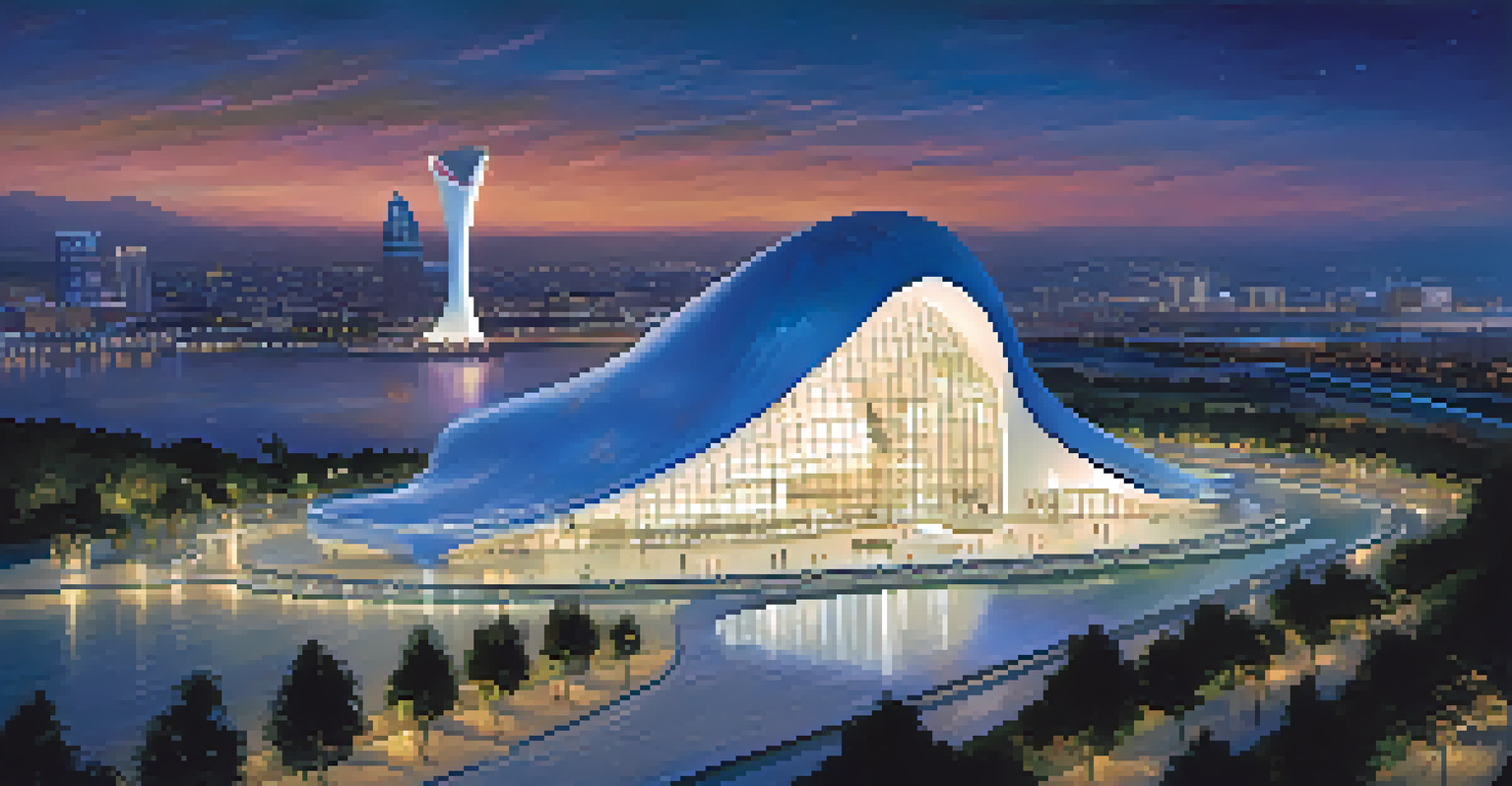Conceptual Art in Architecture: Breaking Traditional Boundaries

Understanding Conceptual Art in Architecture
Conceptual art in architecture challenges the conventional ideas of what a building should be. It emphasizes the concept or idea behind the structure rather than just its aesthetic appeal. This approach invites viewers to think critically about the purpose and meaning of the space they inhabit.
Architecture is the learned game, correct and magnificent, of forms assembled in the light.
For instance, consider the Guggenheim Museum in Bilbao, Spain. Its unique form and flowing lines redefine traditional museum architecture. Here, the building itself becomes a piece of art, provoking discussions about space, light, and structure.
By focusing on the 'why' and 'how' of design, conceptual architecture encourages a deeper connection between the viewer and the space, making us question our surroundings in new and exciting ways.
Historical Context: The Evolution of Architectural Thought
The roots of conceptual art in architecture can be traced back to the avant-garde movements of the early 20th century. Artists and architects began experimenting with forms and functions, leading to a departure from traditional styles. This evolution laid the groundwork for modern architectural practices.

In the 1960s and 70s, figures like Robert Venturi and Frank Gehry pushed boundaries even further, advocating for designs that celebrated complexity and contradiction. Their work encouraged a departure from the minimalist approach prevalent at the time, embracing chaos and diversity in architecture.
Conceptual Art Redefines Architecture
Conceptual art in architecture emphasizes the idea behind structures, encouraging critical thinking about space and its meaning.
As we look at contemporary architecture, we can see how these historical movements have shaped current practices. Today’s architects continuously draw inspiration from this rich history to create innovative and thought-provoking designs.
The Role of Materials in Conceptual Architecture
In conceptual architecture, the choice of materials plays a crucial role in conveying the intended message. Architects often select unconventional materials to evoke specific emotions or reactions from the viewer. For example, the use of glass in modern buildings can create a sense of transparency and openness.
Every building is a product of its time, and should speak to the future as well as the past.
Take the example of the Eden Project in Cornwall, United Kingdom. Its geodesic domes made of hexagonal and pentagonal panels not only serve a functional purpose but also symbolize the interconnectedness of nature. The innovative use of materials reinforces the conceptual theme of environmental sustainability.
By experimenting with various materials, architects can create a dialogue between the building and its surroundings. This interaction enhances the overall experience of the space, encouraging visitors to engage with the architecture on a deeper level.
Conceptual Art and Sustainability in Architecture
Sustainability has become a significant theme in contemporary architecture, often intertwined with conceptual art. Architects are increasingly focused on creating spaces that are environmentally friendly, using designs that minimize waste and energy consumption. This shift reflects a growing awareness of our responsibility towards the planet.
For instance, the Bosco Verticale (Vertical Forest) in Milan showcases how conceptual design can promote biodiversity. Its residential towers are adorned with trees and plants, creating a micro-ecosystem that benefits both residents and the environment. This innovative approach highlights the fusion of art and sustainability.
Sustainability in Design Matters
Contemporary architects are increasingly merging conceptual art with sustainability, creating spaces that reflect ecological responsibility.
By prioritizing sustainability, architects are not only challenging traditional building norms but also redefining the relationship between architecture and nature. This concept encourages a holistic view of design that embraces ecological responsibility.
The Impact of Technology on Conceptual Architecture
Advancements in technology have significantly influenced conceptual art in architecture. Tools like computer-aided design (CAD) and parametric design software allow architects to explore complex forms and structures that were once impossible to create. This technological evolution has opened up new avenues for creative expression in architectural design.
For example, the Heydar Aliyev Center in Baku, Azerbaijan, designed by Zaha Hadid, showcases the fluidity and dynamism achievable through modern technology. Its undulating form challenges traditional architectural conventions, embodying the idea that buildings can be both functional and sculptural.
As technology continues to evolve, it will further shape the future of architectural design. The potential for creating innovative, conceptual structures is limitless, pushing the boundaries of what we consider possible in architecture.
Public Engagement and Conceptual Art in Architecture
Public engagement is a vital aspect of conceptual art in architecture. Many contemporary architects aim to create spaces that invite community interaction and participation. By designing buildings that encourage social interaction, architects can foster a sense of belonging and connection among users.
An excellent example is the High Line in New York City, a repurposed elevated railway transformed into a public park. This project not only revitalized a neglected space but also created a vibrant community hub that encourages social engagement and artistic expression. The High Line demonstrates how conceptual design can enhance public spaces.
Technology Shapes Architectural Innovation
Advancements in technology enable architects to explore complex forms and push the boundaries of traditional designs.
Through such initiatives, architects are redefining the role of architecture in society. They are not just creating structures but are also building communities, making architecture a catalyst for social change.
The Future of Conceptual Art in Architecture
As we look to the future, the role of conceptual art in architecture is bound to expand. With growing global challenges such as climate change and urbanization, architects will increasingly rely on innovative and conceptual solutions to address these issues. This shift presents opportunities for creativity and problem-solving in design.
Moreover, the integration of art into architecture will likely become more pronounced, as architects collaborate with artists to create immersive environments. This collaboration can lead to unique spaces that resonate with users on multiple levels, transforming the way we experience architecture.

Ultimately, the future of conceptual art in architecture promises to be exciting and transformative. As boundaries continue to blur between art and architecture, we can expect to see innovative designs that not only challenge our perceptions but also enrich our lives.